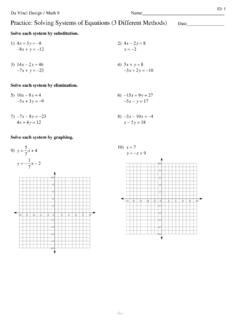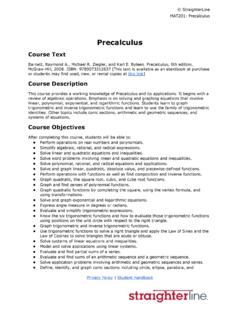Transcription of Mathematics For Economists - Columbia University
1 Mathematics For Economists Mark Dean Introductory Handout for Fall 2014 Class ECON 2010 - Brown University 1 Aims This is the introductory course in Mathematics for incoming economics PhD students at Brown in 2014. In conjunction with the Maths Camp, it has three aims 1. To provide you with the mathematical tools needed to understand your other rst year courses 2. To give you a rst understanding of the concepts that underlie these tools 3. To indoctrinate you into the theorem-proof'method of analysis 2 Administration Contact Details Mark Dean (Instructor). email: O ce: 303C. Phone (401) 863-2097. Website: 1. Victor Aguiar (TA). email: Class Times Classes take place on Tuesdays and Thursdays Lab will take place on Thursdays at in THA 101 116 E (this is on Thayer St) Labs will generally consist of Victor going through the homework from the previous Mark's o ce hours are on Tuesdays (though feel free to get in touch outside these times if you need help).
2 Victor's o ce hours are going to be on Mondays at in the basement of Robinson Hall. I am not going to be here on three Tuesdays during the semester. On these occasions Victor will have his TA sections in my usual Tuesday class slot, and I shall teach in Victor's usual Thursday Lab slot. Details can be found in the Timing'Section below. Homework Schedule Homeworks will be set on the Tuesday of each week, and will be due in the following Tuesday. These homeworks are designed to be quite challenging, and should take between 5 - 8 hours per problem set (depending on how much background you have). Feel free to work in groups if you wish though obviously there is little to be gained by simply copying the answers from someone who knows more than you.
3 Furthermore in previous years we have had problems with students getting hold of answers to homework questions from previous years and literally copying them out. This is dumb, lazy and surprisingly easy to spot, not least because the questions change somewhat from year to year. Please do not do this. 2. Grading Grades will be assigned using an ad hoc formula that puts roughly 20% weight on homework and 40% each on the midterm and nal exams Course Materiels The main source for the course will be my lecture notes, which I will make available on my website at some point after the relevant lecture. Hopefully, these will be pretty complete for the topics I.
4 Cover but (de nitionally) will not cover anything outside the course. The o cial'textbook of the course is Simon, C. and L. Blume, Mathematics for Econo- mists, ( Norton, London 1994). This book is somewhat basic by the standards of modern graduate economics courses, but is well written and organized, and touches on most of the important topics. As such, it is probably worth owning as a reference book. If you are going to get another book, I would recommend Ok. E., Real Analysis with Economic Applications. This is an absolutely excellent textbook, which covers a wide variety of topics in analysis and linear algebra with an economic twist. If you are going to end up as an economist that uses a lot of maths, then you will want to get hold of this book (especially if you are interested in micro theory).
5 A useful analysis text is Rudin, W., Principles of Mathematical Analysis (McGraw-Hill), which is not aimed at Economists , but is more complete. For those interested in macroeconomics, you are almost certainly want to get to grips with dynamic programming in a way that is beyond the scope of this course: Lucas, R., N. Stokey with Prescott, Recursive Methods in Economic Dynamics, (Harvard University Press) is one standard reference here. Another very useful book for dynamic macroeconomics is Galor, O. Discrete Dynamical Systems (Springer). There are also lots of useful lecture notes and problem sets on line, which I will try and point you in the direction of.
6 If you want more materiel, please let me know. 3. 3 Structure Outline This course comes in two parts The rst part is designed to achieve aim 1 - to provide you with the basic tools you need to get you through your rst year courses (and, hopefully, to be able to understand most mainstream articles in economics). This aim should largely been achieved by the maths camp taught by Michael. Victor will cover dynamics and dynamical systems in his rst TA. section, and xed point theorems at some point during the semester The topics that you should understand by this point are listed in the prerequisites'section below. If there is something that on this list that you feel has not been adequately covered then please come and talk to me or Victor.
7 The items I will cover in the main syllabus are listed below. Much of this syllabus will be devoted to providing the mathematical underpinnings for the tools that you are already using. The main di erence between this and what you have already done is that we will be more general, and we will prove many more of the theorems along the way. This section of the course is therefore designed to achieve aims 2 and 3 - to give you a glimpse of what real'maths is about, and to teach you how to use the theorem-proof method of exposition. It may therefore be the case that the immediate relevance of what you think of as economics is not obvious. However, it is still useful for two very important reasons.
8 First, these lectures will give you a background into the tools that you are likely to spend the rest of your career using. It is therefore worth understanding where these tools come from, their limitations and some extensions. Second, some of you will go into elds in which you will need to develop a very high degree of mathematical understanding (this is true in much of theoretical macro, micro and econometrics). You people will need a lot more maths than I teach here, but hopefully this course will act as a bridge that will allow you to understand the proper'maths course that you need. Some things that the course will not cover: First, I do nothing in the way of basic statis- tics, as this will be covered in your econometrics classes.
9 Second, I will not be covering dynamic programming until late in the course, as you will see some of this in your Macro class. 4. Prerequisites Here is a list of the topics that you should be comfortable with before we start on the real'syllabus. Almost all of this stu is in Simon and Blume. For convenience I have put the relevant page numbers in brackets after each topic. Much of it is also covered in your notes from Math Camp. Single and multivariable calculus: De nition of a derivative (24, 300), di erentiable func- tions (29), rst and second derivatives (33), partial and total derivatives (300, 307) directional derivatives (319), Jacobian and Hessian matrices (325, 329), di erentiating polynomials,(27) loga- rithmic and exponential functions (93), expansions and approximations (34, 827), rules for di eren- tiation (product, quotient, chain, etc) (27, 70, 326), implicit function theorem (single and multiple variables) (150, 329) and slopes of indi erence curves (329), tangent plane (309) and di erentiating along a parameterized curve (313), mean value theorem (824) introduction to integration (887).
10 Analysis: Set notation and set properties (847), open, closed and compact sets (264-272), convexity (506), cardinality of sets, sequences in RN (253), summation of arithmetic and geometric sequences, limits and convergence (254), properties of functions:continuity (293), homogeneity (and Euler's theorem) (483-493) and homotheticity (500), concavity and q-concavity (505-527), one-to- one and onto functions, range, domain and image (295-299), basic xed point theorems Static Optimization: Unconstrained optimization:. critical points, sketching a graph (39-43), rst and second order conditions (51-56, 396-407, 836), convexity/concavity (532-537), Weistrass theorem (56).















